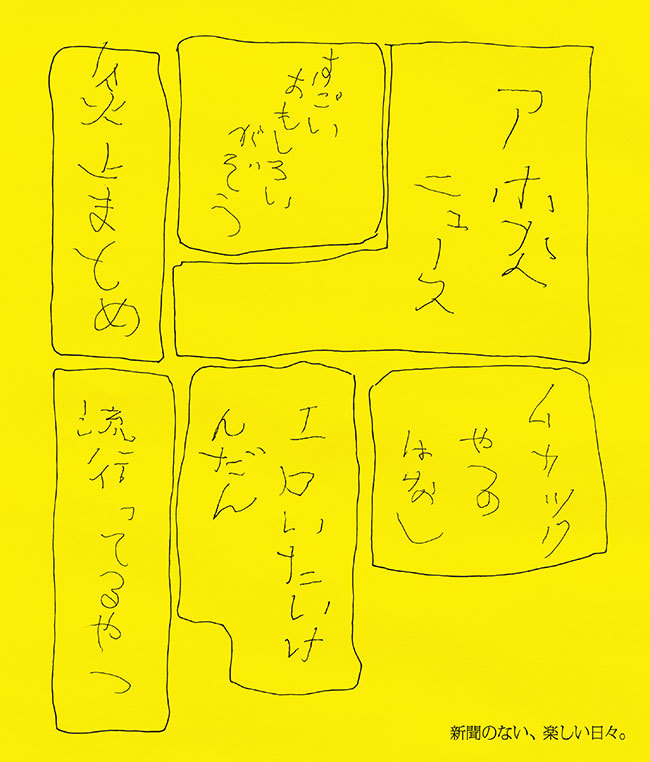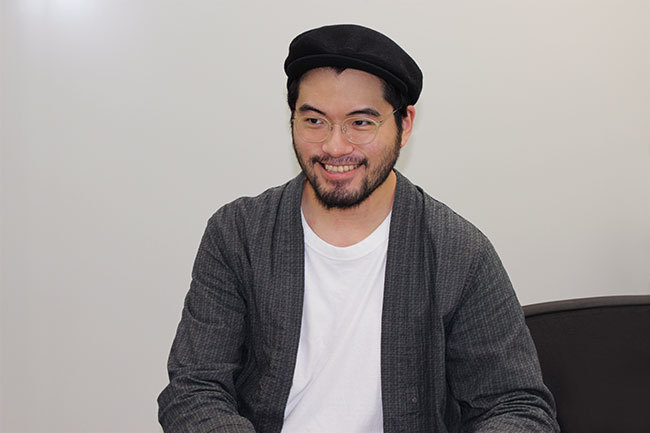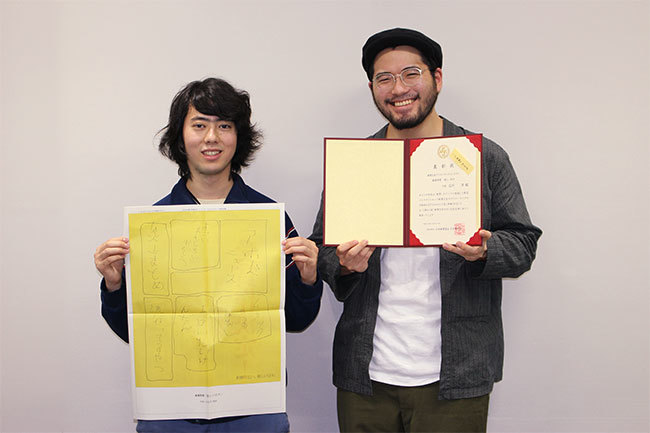The Newspaper Advertising Creative Contest, held annually as a competition for young creators, set "the newspaper itself" as its theme for 2018, attracting 787 entries.
The Grand Prize was awarded to "Happy Days," a work by Art Director Taira Ishikawa (Creative Design Bureau) and Copywriter Kayo Koike (Creative Design Bureau) from Dentsu Inc. Kansai Branch. How did they conceive this work for the theme "Newspaper Advertisements in Newspapers"? And what insights did this competition offer about the value of newspapers?

2018 "Newspaper Advertising Creative Contest" Grand Prize Winner: "Happy Days"
We began by thoroughly examining the "goodness" of newspapers
──Please tell us how you two came to participate this time.

(From left) Kayo Koike, Taira Ishikawa (both Dentsu Inc. Creative Design Bureau)
Koike: I was the one who first considered participating. I'm still in my second year, while Ishikawa-san is a senior in his fourth year. We often talk, so I asked him.
Ishikawa: We hadn't worked together before, but we were aware of each other's work, so I accepted the invitation. Since we were doing it, I wanted to go all out to win an award.
Koike: The reason I invited Ishikawa-san is that, while he's a senior, we're both the type who collaborate closely, consulting each other regardless of seniority. I thought working together would be enjoyable.
Ishikawa: He sometimes talks to me casually, you know (laughs). When discussing projects, seniority doesn't matter. I think it's important to have a relationship where we can speak freely without hesitation.
──And that led to this project. Could you tell us how the idea came about?
Ishikawa: First, we each brought our own initial ideas to the table. But that didn't give us enough depth, so we went back to the basics: what is a newspaper, and what are its "strengths"? This is fundamental to creating any kind of advertising creative—it's hard to promote something that only has half-baked strengths. For example, trying to sell a point where you're inferior to competitors as a strength just lacks credibility.
So we identified the newspaper's strengths, but I struggled with this because I wasn't someone who read newspapers regularly myself. On the other hand, Mr. Koike reads newspapers daily. I think it was beneficial that we could consider both perspectives: someone who reads them regularly and someone who doesn't.
──What specific strengths of newspapers did you identify?

Mr. Taira Ishikawa (Dentsu Inc. Creative Design Bureau)
Ishikawa: Specifically, we identified the overview you get—seeing articles beyond just your interests—the accuracy of the articles, and the credibility backed by deep reporting. Against this backdrop, even with the rise of online media, there's still undeniable value in being published in a newspaper. We brainstormed these "seeds of goodness" together.
Koike: We had several discussions, merging similar elements or expanding others, while creating the work. Ultimately, we submitted about six entries.
However, the winning piece this time wasn't from our "first-string" ideas. It was something Ishikawa-san brought up mid-discussion, saying, "Actually, I have something else like this..." At that point, the overall concept was already formed, but the copy for the bottom right wasn't finalized. Ishikawa-san mentioned, "I'm unsure what to put here."
Expressing that "faint sense of crisis" from not reading the newspaper
──Why did you show this idea to Mr. Koike midway through?
Ishikawa: I guess because it felt closer to my own experience, born from a genuine feeling. As I mentioned earlier, I don't read newspapers much myself; online media is my main source. I can get by just fine, but I do have this faint sense of unease, like "Is it really okay not to read the newspaper?"
I wanted to give shape to that real perspective, but I just couldn't settle on the final copy. It was really tough. So it didn't make the first team, and I ended up showing it to Koike-san later.
Koike: After that, I helped brainstorm copy too. At first, I envisioned something straightforward and easy to understand, making people feel like "I really should read the newspaper." But it just didn't quite click. Then Ishikawa-san came up with the copy, "Fun days without newspapers." It felt like it just clicked perfectly.
What convinced me was that it was copy you could read between the lines. Reading this, some might think "I really should read the newspaper," while others might just think "Yeah, that's true" and leave it at that. The fact it wasn't pushy and allowed for multiple interpretations actually made me think it could lead people to consider the significance of newspapers.
Ishikawa: Personally, I felt it captured a subtle sense of unease well. It's not that online media is bad, nor is it about dismissing it outright. It's more about suggesting, "Is relying solely on that source really okay?" I think I managed to give shape to that "true feeling" I had.
──Could you share any other meticulous details beyond the copywriting?

Koike Kay (Dentsu Inc. Creative Design Bureau)
Koike: Believe it or not, there are quite a few (laughs). For example, we deliberately separated the content and hierarchy of the boxed sections like "News," "Images," and "~Summary." By intentionally avoiding neatness and arranging cluttered information, we aimed to express the feel of the internet. Another detail is lowering the sentence's polish, like using adjectives ending in "i" consecutively, such as "super interesting images." While "super interesting" would be more appropriate, we chose this for effect.
Ishikawa: By the way, Mr. Koike wrote the characters. To bring this idea to life, only his messy handwriting would do. (laugh)
Koike: I mixed writing with both my right and left hands. Since it had to be legible, I kept it at a readable level.
Precisely because of information overload, young people have latent demand for newspapers
──What did you gain from this competition, and what did you find rewarding?
Ishikawa: What struck me is that ideas born from your true feelings are inherently powerful. While some might freely shape ideas, this competition made me realize that in my own creative process, I should prioritize my own perspective without forcing generalization. That will be valuable going forward.
Koike: It was interesting to place an advertisement for the newspaper itself within the newspaper. Since the Grand Prize winner will actually be published as a newspaper ad, I found it incredibly rewarding to be able to convey our ideas directly to people reading the newspaper.
──Finally, could you share your thoughts on the value and role of newspapers as revealed through this competition?
Koike: With the diversification of media and the overwhelming flood of information making it hard to discern what's accurate, I think some people are growing weary of this situation. That's precisely why the newspaper as an option might be reconsidered. The precision and solidity newspapers offer are also a necessary part of the diversity we need in information.
Ishikawa: While young people are often called digital natives, even within that generation, individuals vary in their comfort with digital media. That's precisely why I hope newspapers continue to preserve their unique qualities and value. These are not easily replicable by other new media.
Koike: I suspect many in the digital native generation have had little exposure to newspapers, meaning they may have few opportunities to even recognize the appeal and characteristics I just mentioned. If that's the case, it would be great to create opportunities for them to discover the merits of newspapers, or establish a bridge connecting newspapers and young people. There might be latent demand for newspapers among young people that hasn't yet surfaced.







